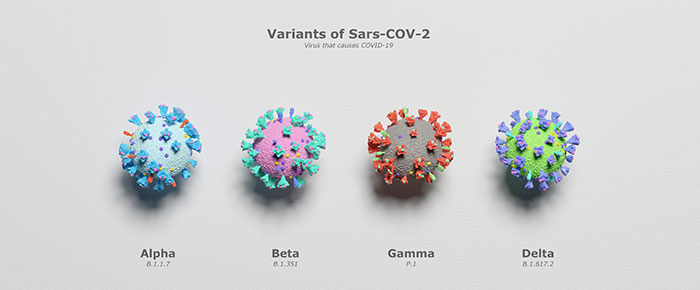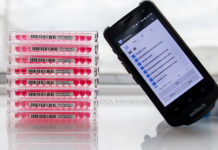
A few months ago, a new COVID-19 variant of concern was identified in South Africa that has since changed the disease landscape throughout the globe: the Omicron variant. As this blog is being written, cases are surging in nearly every region where the variant has spread; some regions are reporting their highest case numbers ever, with no signs of slowing yet. With an ability to spread so fast, even in well-vaccinated populations, the high number of genetic mutations that have occurred in this variant have already begun to elicit phenotypic changes in transmissibility. However, because it’s so early in the game, very little is actually known about the Omicron variant and its pathogenic ability. More importantly, it is still unclear whether these changes are expected to increase or decrease its associated morbidity and mortality.
Key observations with the Omicron variant
The main questions on everyone’s mind are whether this new variant is more transmissible (a resounding yes so far), how much more severe disease it will cause, and what symptoms it will typically cause. Much is still unknown, but because research happens so quickly in the COVID era (by the time this blog is published, the information listed here may be already dated), there are already some clues that might help predict its course.
Differences in the lab
With so much genetic variance, this new Omicron is likely to act much differently than any other SARS-CoV-2 strain. Though the data requires peer review, one group has postulated that Omicron contains 26 amino acid mutations, with 23 substitutions, two deletions, and one insertion. This insertion appears to be unique to Omicron, and the possible DNA sequences that align with the protein insertion they identified match well with sequences found in the genomes of both humans as well as other cold-causing coronaviruses. Therefore, though preliminary, this data might indicate that this new variant obtained new sequences from either organism, potentially in an immunocompromised individual.1
What does this all mean for its ability to infect human cells? One study, yet to be peer reviewed, used histopathology to suggest that this variant has an increased ability to infect human bronchial cells but is much less effective at infecting cells in the lung.2 This observation has some support, as two separate preprint articles provide evidence that the Omicron variant does not infect cells expressing high levels of transmembrane serine protease 2 (TMPRSS2). This protein is important, as activation of the spike protein in other variants, including the Delta variant, is dependent on TMPRSS2, which is highly expressed in the lung compared with the upper airways.3,4
The other critical capability that’s been analyzed relatively quickly is immune escape, which is especially important given the relatively high efficacy of recent COVID-19 vaccines against transmission and severe disease. Serum taken from samples of patients vaccinated with either the BNT162b2 (Pfizer-BioNTech) or ChAdOx-1 (AstraZeneca) vaccines showed more than 10-fold less neutralization of the Omicron strain compared to that with Delta, though patients who received a third dose had a heightened response.3
Differences in the real world
It’s rare that the results of translational research can have such an impact on society so quickly, but this pandemic has shown that basic research can lead to immediate results. In this case, it appears that some of these results may have validity, as several studies, including one from the UK Health Security Agency and one from Public Health Ontario, indicate that this strain, though highly contagious in vaccinated individuals, yields less severe outcomes compared with the Delta variant.5,6 The thought is that because the virus is less capable of infecting the lungs, fewer patients are likely to experience dyspnea caused by severe lung damage.4 In fact, it appears that anecdotal evidence suggests that the symptoms of Omicron may be different from those of Delta and other strains. Some patients have apparently suffered from harsh night sweats, a symptom that was not typically associated with other variants, and it seems that fewer patients experience loss of smell and/or taste.7 Unfortunately, as it’s extremely early on, it’s impossible to tell what the effects of the variant will be regarding the incidences of long COVID or on cardiovascular and neurological function.
When it comes to viewing how Omicron will spread worldwide, some clues are found in South Africa, where the variant was initially discovered. Tong et al described a pattern where the variant, likely present in South Africa in October 2021, initially spread slowly alongside the Delta variant in the Gauteng province. Once Omicron became the dominant variant, its speed accelerated throughout all other provinces, eventually landing at transport hubs and spreading to other regions of the world. The authors also modeled risk based on South African alert level. The country has five alert levels (listed as 1 to 5), with 5 having the harshest of measures, including strict lockdown, with everyone confined to their property unless an essential service is required (like getting groceries or a hospital emergency). They found that by imposing alert level 5 in high-risk regions and allowing surrounding provinces to utilize alert levels 1 to 4, they could potentially cut the risk of spread by nearly 50%. They also showed that increasing the vaccination rate could cut the spread by almost 25%.8
It’s unclear what will happen with COVID-19, even in the coming weeks. With so much genetic variation, many are hoping the Omicron variant represents the beginning of the end of the pandemic, hopefully resulting in the virus becoming less deadly and ultimately endemic, like those coronaviruses that cause the common cold. Only time will tell, and until then, scientists around the world will be keeping a keen eye to help guide public policy based on thorough science.
LabTAG by GA International is a leading manufacturer of high-performance specialty labels and a supplier of identification solutions used in research and medical labs as well as healthcare institutions.
References:
- Venkatakrishnan et al. Omicron variant of SARS-CoV-2 harbors a unique insertion mutation of putative viral or human genomic origin. Preprint, 2021.
- HKUMed finds Omicron SARS-CoV-2 can infect faster and better than Delta in human bronchus but with less severe infection in lung. University of Hong Kong; 2021. Available at: https://www.med.hku.hk/en/news/press/20211215-omicron-sars-cov-2-infection/. Accessed January 1, 2022.
- Meng B et al. SARS-CoV-2 Omicron spike mediated immune escape, infectivity and cell-cell fusion. Preprint, 2021.
- Zhao H et al. SARS-CoV-2 Omicron variant shows less efficient replication and fusion activity when compared with delta variant in TMPRSS2-expressed cells. Emerg Microbes Infect. 2021;1-18.
- Ontario study of COVID-19 cases suggests Omicron not as severe as Delta. CTV News; 2021. Available at : https://toronto.ctvnews.ca/ontario-study-of-covid-19-cases-suggests-omicron-not-as-severe-as-delta-1.5723473. Accessed January 1, 2021.
- Omicron hospitalization risk lower than delta, vaccines provide good protection, U.K. study says. CNBC News; 2021. Available at: https://www.cnbc.com/2021/12/31/omicron-hospitalization-risk-upside-vaccine-protection-good-uk-study-.html. Accessed January 1, 2021.
- Is it COVID-19 or just a cold? Here’s how to tell the difference. Today; 2021. Available at: https://www.today.com/health/health/covid-19-cold-flu-tell-difference-rcna10114. Accessed January 1, 2021.
- Tong C et al. Tracking and controlling the spatiotemporal spread of SARS-CoV-2 Omicron variant in South Africa. Travel Med Infect Dis. 2021;102252.




